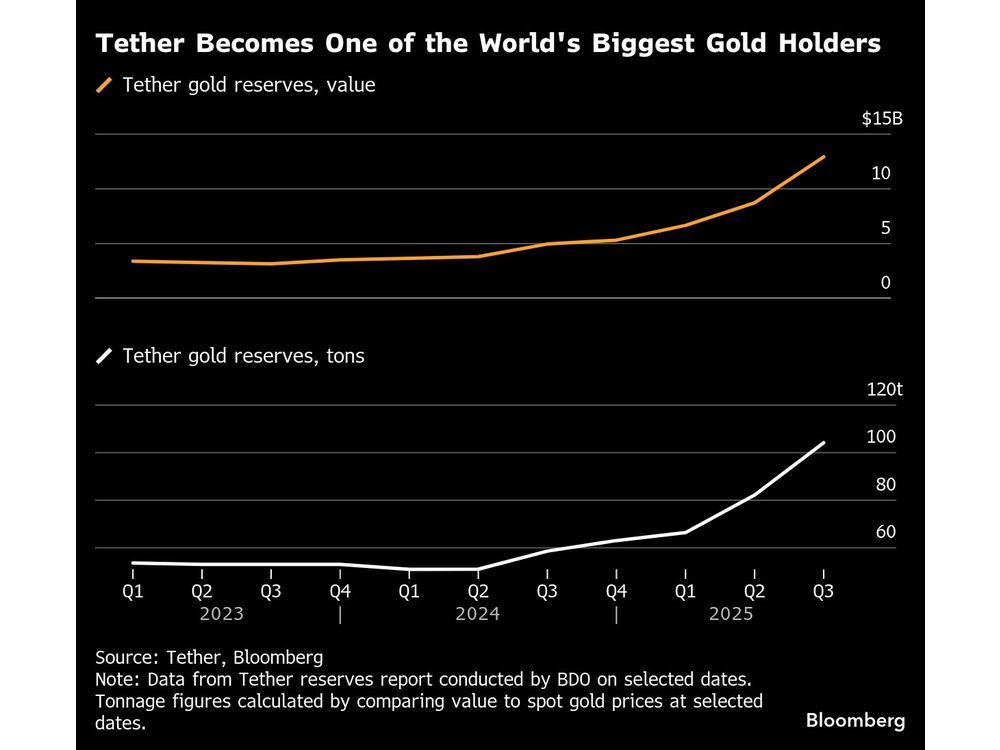Top Stories
Tether Targets Major Growth in Commodity-Trade Lending

Tether Holdings SA, the prominent stablecoin issuer, plans to significantly expand its lending services to commodities traders, having already provided approximately $1.5 billion in credit to the sector. Chief Executive Officer Paolo Ardoino emphasized the company’s commitment to increase financing for various commodities, including oil, cotton, and wheat. This move signals Tether’s ambition to become a key player in the commodities trading finance landscape.
The company, headquartered in El Salvador, has been extending loans in both US dollars and its stablecoin, USDT, which is pegged to the US dollar. While Tether currently holds a smaller market position compared to major banks involved in commodity lending, its substantial reserves of nearly $200 billion offer considerable financial leverage. Ardoino noted that the growing acceptance of USDT in commodity-exporting regions, particularly in Latin America, could enhance the company’s competitive edge.
Strategic Focus on Commodities Financing
Ardoino stated, “We are going to expand dramatically. The team is super bullish.” Credit plays a vital role in the commodities sector, where traditional banking lines facilitate the movement of trillions of dollars worth of goods, including foodstuffs and energy products. Although the majority of commodities trade loans remain denominated in US dollars, Tether may encounter reluctance from firms to borrow in USDT, which could affect its growth strategy.
The commodities lending initiative is part of Tether’s broader Trade Finance unit, launched last year. This division is distinct from the reserves backing its stablecoins. In October 2022, reports indicated that Tether had begun exploring lending opportunities within the credit-hungry commodities sector. The timing is notable, as many traditional banks have scaled back their lending activities following recent market upheavals and fraud allegations.
While leading trading firms like Trafigura and Cargill continue to access extensive lending pools, smaller companies often face challenges in securing necessary financing. This has created a burgeoning market for private credit, particularly in high-risk locations where banks are hesitant to lend. Typically, these private lenders charge double-digit interest rates to offset the associated risks.
Expanding Beyond Lending
Tether’s venture into commodities finance is not limited to lending; the firm is also building a significant presence in precious metals. Recent reports revealed that Tether is hiring senior precious metals traders from HSBC Holdings Plc as part of its strategy to enhance its operations in this sector. Tether’s gold-backed stablecoin now boasts a market value of nearly $2.2 billion, according to CoinGecko data.
In March 2023, Tether announced plans to invest up to $616 million to increase its stake in South American agricultural and energy firm Adecoagro SA to 70%. The company also appointed commodity trading veteran Kyril Louis-Dreyfus to its board in April, further strengthening its position in the commodities market.
As Tether continues to diversify its operations, the demand for stablecoins is on the rise, driven by their growing adoption for transfers, remittances, and payments. The recent stablecoin legislation passed in the United States in July 2023 is expected to further bolster the market. With USDT leading the sector, Tether generates billions in interest annually from the reserves required to back its coins.
Looking ahead, Ardoino anticipates that Tether will report a profit of approximately $15 billion for 2025. While Tether’s financial results are not audited, the company’s ambitions and strategic moves in commodities lending and beyond position it as a growing force in the global financial landscape.
-

 Education3 months ago
Education3 months agoBrandon University’s Failed $5 Million Project Sparks Oversight Review
-

 Science4 months ago
Science4 months agoMicrosoft Confirms U.S. Law Overrules Canadian Data Sovereignty
-

 Lifestyle3 months ago
Lifestyle3 months agoWinnipeg Celebrates Culinary Creativity During Le Burger Week 2025
-

 Health4 months ago
Health4 months agoMontreal’s Groupe Marcelle Leads Canadian Cosmetic Industry Growth
-

 Science4 months ago
Science4 months agoTech Innovator Amandipp Singh Transforms Hiring for Disabled
-

 Technology4 months ago
Technology4 months agoDragon Ball: Sparking! Zero Launching on Switch and Switch 2 This November
-

 Education4 months ago
Education4 months agoRed River College Launches New Programs to Address Industry Needs
-

 Technology4 months ago
Technology4 months agoGoogle Pixel 10 Pro Fold Specs Unveiled Ahead of Launch
-

 Business3 months ago
Business3 months agoRocket Lab Reports Strong Q2 2025 Revenue Growth and Future Plans
-

 Technology2 months ago
Technology2 months agoDiscord Faces Serious Security Breach Affecting Millions
-

 Education4 months ago
Education4 months agoAlberta Teachers’ Strike: Potential Impacts on Students and Families
-

 Education3 months ago
Education3 months agoNew SĆIȺNEW̱ SṮEȽIṮḴEȽ Elementary Opens in Langford for 2025/2026 Year
-

 Science4 months ago
Science4 months agoChina’s Wukong Spacesuit Sets New Standard for AI in Space
-

 Business4 months ago
Business4 months agoBNA Brewing to Open New Bowling Alley in Downtown Penticton
-

 Business4 months ago
Business4 months agoNew Estimates Reveal ChatGPT-5 Energy Use Could Soar
-

 Technology4 months ago
Technology4 months agoWorld of Warcraft Players Buzz Over 19-Quest Bee Challenge
-

 Business4 months ago
Business4 months agoDawson City Residents Rally Around Buy Canadian Movement
-

 Technology4 months ago
Technology4 months agoFuture Entertainment Launches DDoD with Gameplay Trailer Showcase
-

 Technology2 months ago
Technology2 months agoHuawei MatePad 12X Redefines Tablet Experience for Professionals
-

 Top Stories3 months ago
Top Stories3 months agoBlue Jays Shift José Berríos to Bullpen Ahead of Playoffs
-

 Technology4 months ago
Technology4 months agoGlobal Launch of Ragnarok M: Classic Set for September 3, 2025
-

 Technology4 months ago
Technology4 months agoInnovative 140W GaN Travel Adapter Combines Power and Convenience
-

 Science4 months ago
Science4 months agoXi Labs Innovates with New AI Operating System Set for 2025 Launch
-

 Technology4 months ago
Technology4 months agoNew IDR01 Smart Ring Offers Advanced Sports Tracking for $169










